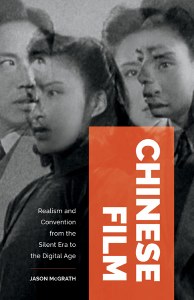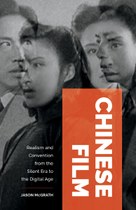Chinese Film
Realism and Convention from the Silent Era to the Digital Age
Jason McGrath

OPEN-ACCESS MANIFOLD EDITION
PDF Download
Open-access formats of this title are supported by TOME
In Chinese Film, Jason McGrath traces the varied claims to cinematic realism made by Chinese filmmakers, critics, and scholars. He presents realism as an aesthetic form that negotiates between cultural conventions and the ever-evolving real, envisioning it as more than just a cinematic question and showing how the struggle for realism is central to the Chinese struggle for modernity itself.
"This magisterial book is an extraordinary landmark in both Chinese film studies and the broader exploration of cinema itself. In his multifaceted paradigm of realism, Jason McGrath finds a master code for understanding Chinese film across the span of its history: conceptually vivid and analytically riveting, this superb study is a must-read for any student or scholar of the moving image."
—Margaret Hillenbrand, author of Negative Exposures: Knowing What Not to Know in Contemporary China
The history of Chinese cinema is as long and complicated as the tumultuous history of China itself. Each Chinese cinematic era, whether the silent, the Communist, or the contemporary, has necessitated its own form in conversation with broader trends in politics and culture.
In Chinese Film, Jason McGrath tells this fascinating story by tracing the varied claims to cinematic realism made by Chinese filmmakers, officials, critics, and scholars. Understanding realism as a historical dynamic that is both enabled and mitigated by aesthetic conventions of the day, he analyzes it across six different types of claims: ontological, perceptual, fictional, social, prescriptive, and apophatic.
Through this method, McGrath makes major claims not just about Chinese cinema but also about realism as an aesthetic form that negotiates between cultural conventions and the ever-evolving real. He comes to envision this as more than just a cinematic question, showing how the struggle for realism is central to the Chinese struggle for modernity.
$30.00 paper ISBN 978-1-5179-1403-5
$120.00 cloth ISBN 978-1-5179-1402-8
416 pages, 67 b&w photos, 5 1/2 x 8 1/2, January 2023

Jason McGrath is professor in the Department of Asian and Middle Eastern Studies at the University of Minnesota–Twin Cities, where he is also on the faculty in Moving Image, Media, and Sound Studies. He is author of Postsocialist Modernity: Chinese Cinema, Literature, and Criticism in the Market Age.

This magisterial book is an extraordinary landmark in both Chinese film studies and the broader exploration of cinema itself. In his multifaceted paradigm of realism, Jason McGrath finds a master code for understanding Chinese film across the span of its history: conceptually vivid and analytically riveting, this superb study is a must-read for any student or scholar of the moving image.
Margaret Hillenbrand, author of Negative Exposures: Knowing What Not to Know in Contemporary China
Meticulously researched, Chinese Film focuses on the multiple manifestations of realism in the longue durée history, tracking a key aesthetic-political articulation embedded in the film medium in general and Chinese cinema in particular. Especially valuable is Jason McGrath’s insistence on situating each mode of realism and its transformation within richly textured historical contexts.
Yiman Wang, author of Remaking Chinese Cinema: Through the Prism of Shanghai, Hong Kong, and Hollywood
Chinese Film: Realism and Convention from the Silent Era to the Digital Age is one of the most ambitious, thought-provoking, and groundbreaking works on the subject to date.
Modern Chinese Literature & Cultures
This magnum opus—the fruit of many years’ work and thought—rethinks cinematic realism and proposes it as a conceptual framework for making sense of Chinese cinema as a whole.
The China Journal
Chinese Film is ambitious both in its historical scope and intellectual claims. (One sometimes wonders, in fact, what isn’t encompassed by McGrath’s expansive typology of realisms.) Well written and researched, the book is sure to reach a broad audience in film studies.
China Quarterly
McGrath offers a cross-cultural perspective with scholarly research and cinematic examples from China and other cultures including the United States, France, Korea, Iran, and Japan. His approach bridges the distances that may exist between these cultures, and the book’s in-depth engagement with a multitude of writings on cinematic realism provides a solid theoretical foundation for the historical study of Chinese cinematic realism.
Film Quarterly

Contents
Preface and Acknowledgments
Introduction. Inscribing the Real: Cinematic Realism and Convention
1. Acting Real in Chinese Silent Cinema
2. Shanghaiing Hollywood in the 1930s
3. Realism and Event in Postwar Chinese Cinema
4. Prescriptive Realism in Revolutionary Cinema of the Seventeen Years
5. Socialist Formalism and the End(s) of Revolutionary Cinema
6. A Long Take on Post–Socialist Realism
7. Chinese Cinematic Realism(s) in the Digital Age
Conclusion
Notes
Index





